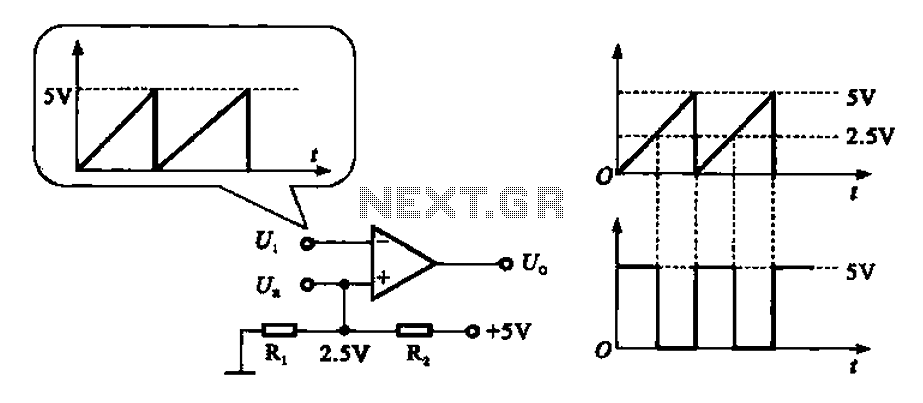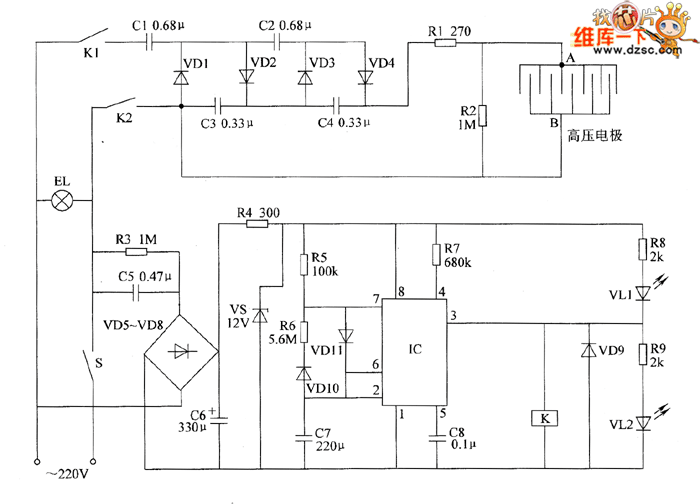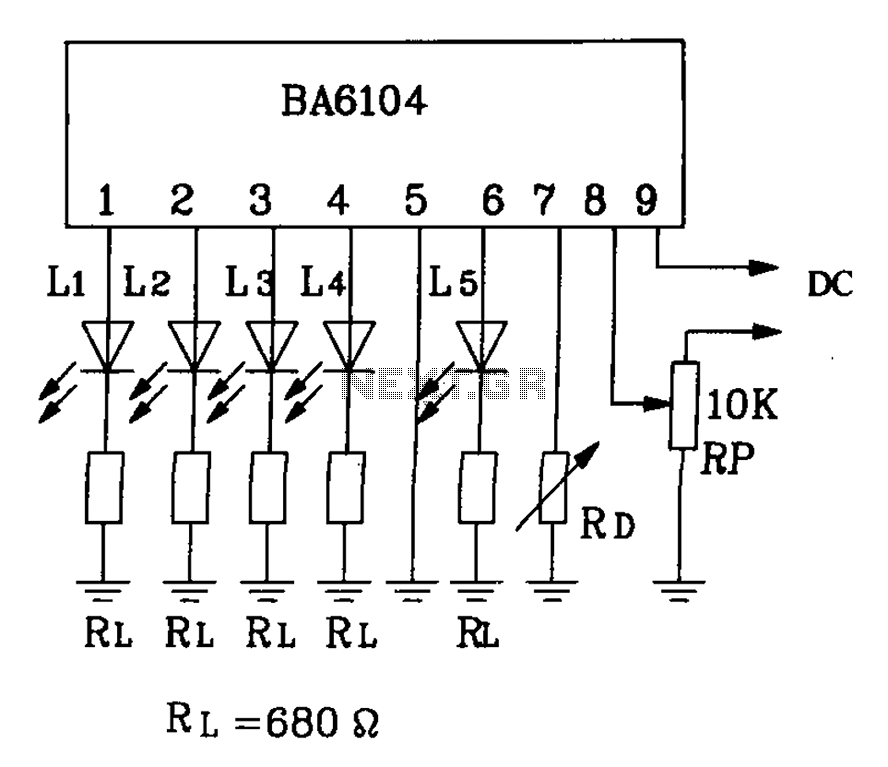
IC Controlled Emergency Light with Charger Circuit Schematic Free With Explanation

The circuit presented is an integrated circuit (IC) controlled emergency light. Its key features include automatic activation of the light during mains failure and a battery charger equipped with overcharge protection. In the absence of mains power, relay RL2 remains de-energized, allowing battery supply to power the inverter section through its normally closed (N/C) contacts and switch S1. The inverter section consists of IC2 (NE555), which operates in astable mode to generate sharp pulses at a frequency of 50 Hz for driving the MOSFETs. The output from IC3 is directly connected to the gate of MOSFET (T4), while it is inverted by transistor T2 before being applied to the gate of MOSFET (T3). Consequently, the power amplifier, which is constructed around MOSFETs T3 and T4, operates in a push-pull configuration. The output across the secondary of transformer X2 is capable of powering a 230-volt, 20-watt fluorescent tube. If illumination is not desired during a mains failure, switch S1 can be turned off. The battery overcharge protection circuit is designed using IC1 (LM308). The non-inverting pin is set to a reference voltage of approximately 6.9 volts, achieved through diode D5 (1N4148) and a 6.2-volt zener diode D6. The inverting pin of IC1 connects to the positive terminal of the battery. When mains power is available, the output of IC1 remains high unless the battery voltage surpasses 6.9 volts. In this scenario, transistor T1 is forward biased, energizing relay RL1, which keeps the battery charging through the normally open (N/O) contacts of relay RL1 and current limiting resistor R2. When the battery voltage exceeds 6.9 volts, indicating an overcharged condition, the output of IC1 drops low, de-energizing relay RL1 and halting further battery charging. MOSFETs T3 and T4 should be mounted on appropriate heat sinks.
The integrated circuit controlled emergency light circuit is designed for reliability and efficiency in power management during mains failure. The NE555 timer, configured in astable mode, generates a continuous square wave output, which is crucial for driving the MOSFETs that control the inverter section. This configuration allows for effective conversion of the DC battery voltage to an AC output suitable for powering standard fluorescent lighting.
The use of a push-pull amplifier configuration with MOSFETs T3 and T4 enhances the circuit's efficiency, allowing for higher output power while minimizing heat generation. The selection of a transformer (X2) that can handle the required voltage and power ratings ensures that the circuit can operate safely and effectively under load conditions.
The overcharge protection mechanism is critical for maintaining battery health and longevity. The LM308 comparator monitors the battery voltage continuously, providing a feedback loop that prevents overcharging. By utilizing a zener diode to set a precise reference voltage, the circuit can accurately determine when to stop charging the battery, thereby preventing damage due to excessive voltage.
Overall, this emergency light circuit effectively combines automatic operation, power management, and safety features, making it suitable for various applications where reliable lighting is necessary during power outages. Proper thermal management of the MOSFETs is essential; therefore, adequate heat sinks must be used to ensure that the components operate within safe temperature limits.The circuit shown here is that of the IC controlled emergency light. Its main features are: automatic switching-on of the light on mains failure and battery charger with overcharge protection. When mains is absent, relay RL2 is in deenergised state, feeding battery supply to inverter section via its N/C contacts and switch S1.
The inverter section comprises IC2 (NE555) which is used in stable mode to produce sharp pulses at the rate of 50 Hz for driving the MOSFETs. The output of IC3 is fed to gate of MOSFET (T4) directly while it is applied to MOSFET (T3) gate after inversion by transistor T2.
Thus the power amplifier built around MOSFETs T3 and T4 functions in push-pull mode. The output across secondary of transformer X2 can easily drive a 230-volt, 20-watt fluorescent tube. In case light is not required to be on during mains failure, simply flip switch S1 to off position. Battery overcharge preventer circuit is built around IC1 (LM308). Its non inverting pin is held at a reference voltage of approximately 6. 9 volts which is obtained using diode D5 (1N4148) and 6. 2-volt zener D6. The inverting pin of IC1 is connected to the positive terminal of battery. Thus when mains supply is present, IC1 comparator output is high, unless battery voltage exceeds 6. 9 volts. So transistor T1 is normally forward biased, which energises relay RL1. In this state the battery remains on charge via N/O contacts of relay RL1 and current limiting resistor R2. When battery voltage exceeds 6. 9 volts (overcharged condition), IC1 output goes low and relay RL1 gets deenergised, and thus stops further charging of battery.
MOSFETs T3 and T4 may be mounted on suitable heat sinks. 🔗 External reference
The integrated circuit controlled emergency light circuit is designed for reliability and efficiency in power management during mains failure. The NE555 timer, configured in astable mode, generates a continuous square wave output, which is crucial for driving the MOSFETs that control the inverter section. This configuration allows for effective conversion of the DC battery voltage to an AC output suitable for powering standard fluorescent lighting.
The use of a push-pull amplifier configuration with MOSFETs T3 and T4 enhances the circuit's efficiency, allowing for higher output power while minimizing heat generation. The selection of a transformer (X2) that can handle the required voltage and power ratings ensures that the circuit can operate safely and effectively under load conditions.
The overcharge protection mechanism is critical for maintaining battery health and longevity. The LM308 comparator monitors the battery voltage continuously, providing a feedback loop that prevents overcharging. By utilizing a zener diode to set a precise reference voltage, the circuit can accurately determine when to stop charging the battery, thereby preventing damage due to excessive voltage.
Overall, this emergency light circuit effectively combines automatic operation, power management, and safety features, making it suitable for various applications where reliable lighting is necessary during power outages. Proper thermal management of the MOSFETs is essential; therefore, adequate heat sinks must be used to ensure that the components operate within safe temperature limits.The circuit shown here is that of the IC controlled emergency light. Its main features are: automatic switching-on of the light on mains failure and battery charger with overcharge protection. When mains is absent, relay RL2 is in deenergised state, feeding battery supply to inverter section via its N/C contacts and switch S1.
The inverter section comprises IC2 (NE555) which is used in stable mode to produce sharp pulses at the rate of 50 Hz for driving the MOSFETs. The output of IC3 is fed to gate of MOSFET (T4) directly while it is applied to MOSFET (T3) gate after inversion by transistor T2.
Thus the power amplifier built around MOSFETs T3 and T4 functions in push-pull mode. The output across secondary of transformer X2 can easily drive a 230-volt, 20-watt fluorescent tube. In case light is not required to be on during mains failure, simply flip switch S1 to off position. Battery overcharge preventer circuit is built around IC1 (LM308). Its non inverting pin is held at a reference voltage of approximately 6. 9 volts which is obtained using diode D5 (1N4148) and 6. 2-volt zener D6. The inverting pin of IC1 is connected to the positive terminal of battery. Thus when mains supply is present, IC1 comparator output is high, unless battery voltage exceeds 6. 9 volts. So transistor T1 is normally forward biased, which energises relay RL1. In this state the battery remains on charge via N/O contacts of relay RL1 and current limiting resistor R2. When battery voltage exceeds 6. 9 volts (overcharged condition), IC1 output goes low and relay RL1 gets deenergised, and thus stops further charging of battery.
MOSFETs T3 and T4 may be mounted on suitable heat sinks. 🔗 External reference





